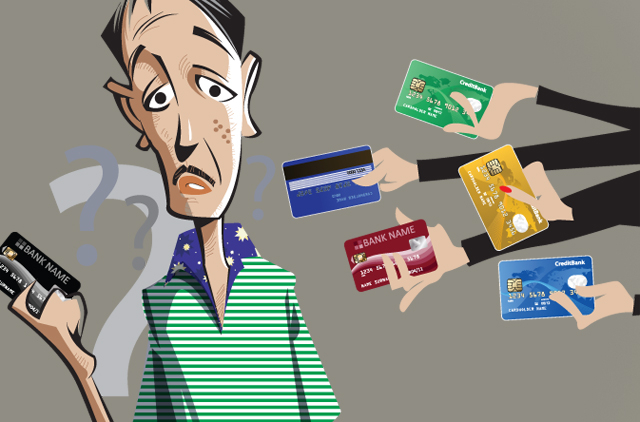
Credit cards are probably one of the most important inventions in the world of personal finance.
They're considered more secure than cash and make carrying around bundles of paper bills almost obsolete. All you need to do is swipe and you're done.
According to MasterCard, about 59 per cent of residents in the UAE own credit cards, while four out of five travellers living in the Middle East and Levant own at least one type of payment card as of 2007. Although the figures have not been updated, there's still an abundance of credit card usage in the UAE, as shown by online shopping behaviour of consumers.
MasterCard's latest survey reveals that in the last quarter of 2009, UAE online shoppers spent an average of $1,048 (Dh3,846), the highest in the Asia/Pacific, Middle East and Africa region. The number of average purchases, however, dropped from 4.2 in 2008 to four in 2009, as many residents tightened their belts.
Convenience, however, has a price. Credit card interest rates in the UAE have been on the rise, as banks cope with rising defaults. One bank, for instance, increased its monthly finance charges for retail transactions from 2.29 per cent in 2007 to 2.69 per cent recently.
"It can be observed that a number of banks have increased their interest rates since the beginning of 2008 on all their products, not just credit cards. This move was partly driven by their higher cost of funding but primarily driven by their need to compensate for defaults and provisions made on their non-performing loans (NPLs)," explains Zaid Kamhawi, chief business officer of Emcredit, a government-backed credit bureau in the UAE.
"It can also be noted that if all banks tend to follow the same approach, they eliminate the options for consumers to move to another bank that offers a better price. The only way for banks to lower interest rates is either through regulation or through tougher competition," he adds.
UAE consumers also pay more out of their pockets for outstanding credit. Interest rates in the country are double those in markets outside the Middle East, owing to lack of credit ratings and lenders' fears that borrowers are more likely to default.
"They are higher than in the UK, most of Europe, Japan and the US. Risks are higher in the UAE than in developed countries with sensible credit information available. There, poor risk clients are rejected by cheaper card operators and forced to take more expensive cards," notes Steve Gregory, director of technical services of Holborn Assets.
A study on various credit card packages offered by banks indicates that monthly interest rates hover between two per cent and 2.99 per cent. This, however, doesn't mean that the annual interest rates will be at least 24 per cent.
"It's a real rate of almost 30 per cent annually," says Gregory. That's a far cry from the 14.6 per cent annual percentage rate in the US and the 18.8 per cent in the UK.
While interest charges in other markets can vary according to a borrower's credit profile, most banks in the country charge all customers a uniform rate for a specific product. Hence, a clean credit record does not always guarantee a low interest rate.
"Most of the banks have one rate only for all of their customers. Some offer a preferential rate for people who qualify by salary size or net worth, but there is no ability to differentiate poor risk from better risk clients at this time," Gregory says.
The main reason behind this, Kamhawi explains, is that most banks in the UAE do not have access to comprehensive credit information on the payment behaviour and creditworthiness of the borrower.
"In the absence of such information, banks subject themselves to what is known as adverse selection, or in other words attracting or losing the wrong type of customer. Lending institutions usually do that by pricing their products like credit cards in such a manner that it leads to charging all customers the same interest rate. In doing so, they end up forcing good borrowers to compensate for the losses of more risky borrowers," says Kamhawi.
"In other regions, the credit character of the borrower plays a key part in allowing banks to charge interest rates that reflect the risk profile of the customer, a method known as risk-premium pricing," he adds.
The number of credit card defaults in the UAE has been on the rise. Kamhawi says defaults are always going to be part of any lending business. The challenge for banks is to identify and reject accounts with a high probability of defaulting before accepting them, or manage them before they default.
"However, in times of tight credit conditions as is being witnessed in the UAE today, the ratio of defaulting accounts to total loans is growing, partly because economic conditions are forcing more people to default on their payments and partly because banks are not growing their loan books at the same rate as they used to. As a result, their total percentage of NPLs is on the rise," says Kamhawi.
To tackle rising defaults, Kamhawi suggests creating an incentive for good payment behaviour or, similarly, a "disincentive" for default. Good incentives can include offering lower interest rates and better credit terms.
He notes that credit bureaus in developed countries have been very effective because they have managed to create a "self-discipline mechanism" among borrowers that has proven to be more effective than criminal proceedings.
"With a self-discipline mechanism, borrowers who display tardy payment behaviour on their loans payments will be restricted in their access to future loans, will pay higher interest rates to reflect their risk profile, and may even find it difficult to complete a number of other transactions, such as leasing of an apartment or vehicle," he adds.
Disclaimer: The contents of this section are for guidance purposes only and should not be relied upon as definitive or authoritative in relation to any specific use. Gulf News does not accept any liability for the results of any action taken on the basis of the above information.













